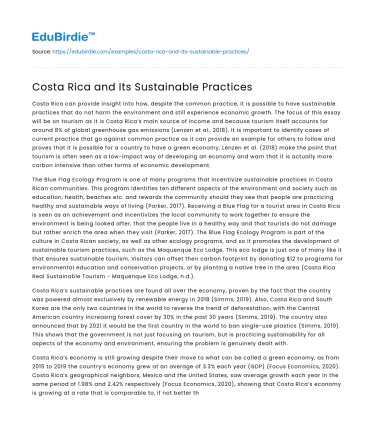Costa Rica can provide insight into how, despite the common practice, it is possible to have sustainable practices that do not harm the environment and still experience economic growth. The focus of this essay will be on tourism as it is Costa Rica’s main source of income and because tourism itself accounts for around 8% of global greenhouse gas emissions (Lenzen et al., 2018). It is important to identify cases of current practice that go against common practice as it can provide an example for others to follow and proves that it is possible for a country to have a green economy. Lenzen et al. (2018) make the point that tourism is often seen as a low-impact way of developing an economy and warn that it is actually more carbon intensive than other forms of economic development.
The Blue Flag Ecology Program is one of many programs that incentivize sustainable practices in Costa Rican communities. This program identifies ten different aspects of the environment and society such as education, health, beaches etc. and rewards the community should they see that people are practicing healthy and sustainable ways of living (Parker, 2017). Receiving a Blue Flag for a tourist area in Costa Rica is seen as an achievement and incentivizes the local community to work together to ensure the environment is being looked after, that the people live in a healthy way and that tourists do not damage but rather enrich the area when they visit (Parker, 2017). The Blue Flag Ecology Program is part of the culture in Costa Rican society, as well as other ecology programs, and so it promotes the development of sustainable tourism practices, such as the Maquenque Eco Lodge. This eco lodge is just one of many like it that ensures sustainable tourism. Visitors can offset their carbon footprint by donating $12 to programs for environmental education and conservation projects, or by planting a native tree in the area (Costa Rica Real Sustainable Tourism - Maquenque Eco Lodge, n.d.).
Save your time!
We can take care of your essay
- Proper editing and formatting
- Free revision, title page, and bibliography
- Flexible prices and money-back guarantee
Costa Rica’s sustainable practices are found all over the economy, proven by the fact that the country was powered almost exclusively by renewable energy in 2018 (Simms, 2019). Also, Costa Rica and South Korea are the only two countries in the world to reverse the trend of deforestation, with the Central American country increasing forest cover by 30% in the past 30 years (Simms, 2019). The country also announced that by 2021 it would be the first country in the world to ban single-use plastics (Simms, 2019). This shows that the government is not just focusing on tourism, but is practicing sustainability for all aspects of the economy and environment, ensuring the problem is genuinely dealt with.
Costa Rica’s economy is still growing despite their move to what can be called a green economy, as from 2015 to 2019 the country’s economy grew at an average of 3.3% each year (GDP) (Focus Economics, 2020). Costa Rica’s geographical neighbors, Mexico and the United States, saw average growth each year in the same period of 1.98% and 2.42% respectively (Focus Economics, 2020), showing that Costa Rica’s economy is growing at a rate that is comparable to, if not better than, economies that are centered on fossil fuels and unsustainable practices. It can be said that Costa Rica has managed to decouple economic growth from environmental pressure. However, whilst this is a great achievement for a country that is small and still developing, it does not reflect global practices. It is unlikely that other countries will follow suit.






 Stuck on your essay?
Stuck on your essay?

